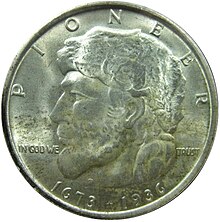United States | |
| Value | 50 cents (0.50 US dollars) |
|---|---|
| Mass | 12.5 g |
| Diameter | 30.61 mm (1.20 in) |
| Thickness | 2.15 mm (0.08 in) |
| Edge | Reeded |
| Composition |
|
| Silver | 0.36169 troy oz |
| Years of minting | 1936 |
| Mintage | 25,015 (5,000 melted) |
| Mint marks | None, all pieces struck at Philadelphia Mint without mint mark |
| Obverse | |
 | |
| Design | Bust of a pioneer |
| Designer | Trygve Rovelstad |
| Design date | 1936 |
| Reverse | |
 | |
| Design | Pioneer family |
| Designer | Trygve Rovelstad |
| Design date | 1936 |
The Elgin, Illinois, Centennial half dollar was a fifty-cent commemorative coin issued by the United States Bureau of the Mint in 1936, part of the wave of commemoratives authorized by Congress and struck that year. Intended to commemorate the centennial of the founding of Elgin, the piece was designed by local sculptor Trygve Rovelstad. The obverse depicts an idealized head of a pioneer man. The reverse shows a grouping of pioneers, and is based upon a sculptural group that Rovelstad hoped to build as a memorial to those who settled Illinois, but which was not erected in his lifetime.
Rovelstad had heard of other efforts to gain authorization for commemorative coins, which were sold by the Mint to a designated group at face value and then retailed to the public at a premium. In 1935, through his congressman, he had legislation introduced into the House of Representatives for a commemorative coin in honor of Elgin's centennial that year. Rovelstad hoped that the proposed coin would both depict and be a source of funds for his memorial to the pioneers. Texas coin dealer L.W. Hoffecker heard of the effort and contacted Rovelstad to offer his assistance—Hoffecker had been a force behind the Old Spanish Trail half dollar, issued in 1935 and distributed by him.
The bill for the Elgin coin did not pass until 1936. Hoffecker was able to sell about 20,000 coins, four-fifths of the issue: the remaining 5,000 were returned to the Mint for melting. Unlike many commemorative coins of that era, the piece was not bought up by dealers and speculators, but was sold directly to collectors at the issue price. Art historian Cornelius Vermeule considered the Elgin coin among the most outstanding American commemoratives.